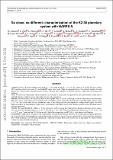So close, so different : characterization of the K2-36 planetary system with HARPS-N
Abstract
Context. K2-36 is a K dwarf orbited by two small (Rb = 1.43 ± 0.08 R⊕ and Rc = 3.2 ± 0.3 R⊕), close-in (ab = 0.022 AU and ac = 0.054 AU) transiting planets discovered by the Kepler/K2 space observatory. They are representatives of two distinct families of small planets (Rp < 4 R⊕) recently emerged from the analysis of Kepler data, with likely a different structure, composition and evolutionary pathways. Aims. We revise the fundamental stellar parameters and the sizes of the planets, and provide the first measurement of their massesand bulk densities, which we use to infer their structure and composition. Methods. We observed K2-36 with the HARPS-N spectrograph over∼3.5 years, collecting 81 useful radial velocity measurements. The star is active, with evidence for increasing levels of magnetic activity during the observing time span. The radial velocity scatter is ∼17 m s−1 due to the stellar activity contribution, which is much larger than the semi-amplitudes of the planetary signals. We tested different methods for mitigating the stellar activity contribution to the radial velocity time variations and measuring the planet masses with good precision. Results. We found that K2-36 is likely a∼1 Gyr old system, and by treating the stellar activity through a Gaussian process regression, we measured the planet masses mb = 3.9 ± 1.1 M⊕ and mc = 7.8 ± 2.3 M⊕. The derived planet bulk densities ρb = 7.2+2.5−2.1 g cm−3 and ρc = 1.3+0.7-0.5 g cm−3 point out that K2-36 b has a rocky, Earth-like composition, and K2-36 c is a low-density sub-Neptune. Conclusions. Composed of two planets with similar orbital separations but different densities, K2-36 represents an optimal laboratory for testing the role of the atmospheric escape in driving the evolution of close-in, low-mass planets after ∼1 Gyr from their formation. Due to their similarities, we performed a preliminary comparative analysis between the systems K2-36 and Kepler-36, which we deem worthy of a more detailed investigation.
Citation
Damasso , M , Zeng , L , Malavolta , L , Mayo , A , Sozzetti , A , Mortier , A , Buchhave , L A , Vanderburg , A , Lopez-Morales , M , Bonomo , A S , Cameron , A C , Coffinet , A , Figueira , P , Latham , D W , Mayor , M , Molinari , E , Pepe , F , Phillips , D F , Poretti , E , Rice , K , Udry , S & Watson , C A 2019 , ' So close, so different : characterization of the K2-36 planetary system with HARPS-N ' , Astronomy & Astrophysics , vol. 624 , A38 . https://doi.org/10.1051/0004-6361/201834671
Publication
Astronomy & Astrophysics
Status
Peer reviewed
ISSN
0004-6361Type
Journal article
Description
A.C.C. acknowledges support from the Science & Technology Facilities Council (STFC) consolidated grant number ST/R000824/1. C.A.W. acknowledges support from the STFC grant ST/P000312/1. The HARPS-N project has been funded by the Prodex Program of the Swiss Space Office (SSO), the Harvard University Origins of Life Initiative (HUOLI), the Scottish Universities Physics Alliance (SUPA), the University of Geneva, the Smithsonian Astrophysical Observatory (SAO), and the Italian National Astrophysical Institute (INAF), the University of St Andrews, Queen’s University Belfast, and the University of Edinburgh. The research leading to these results received funding from the European Union Seventh Framework Programme (FP7/2007- 2013) under grant agreement number 313014 (ETAEARTH).Collections
Items in the St Andrews Research Repository are protected by copyright, with all rights reserved, unless otherwise indicated.

